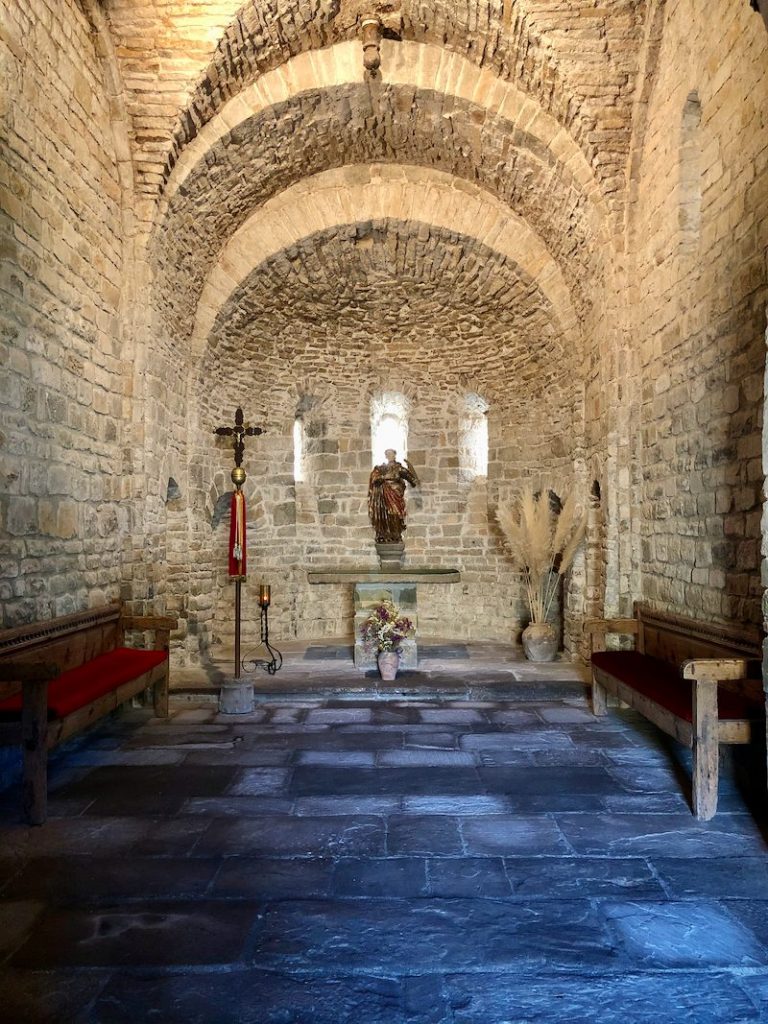Doing the Camino de Santiago through Aragon and not approaching the Royal Monastery of San Juan de la Peña is a missed opportunity to discover a fundamental part of the history of Aragon. The access route also allows you to visit Santa Cruz de la Serós and the entire natural environment of the Protected Landscape of San Juan de la Peña and Monte Oroel.
In San Juan de la Peña you can visit the old monastery, the new one and inside it, two interpretation centers: one dedicated to the history of the monastery and the other to the origin of the Kingdom of Aragon. It is one of the areas of the latter where you can see the relationship with the Camino de Santiago.

Below you can see some spherical photos of the cloister and the interior area.
Variant of the Aragonese Way of St. James
If you are doing the Aragonese Way, you would have two options:
- Spend a day in Jaca and go by bus or car to enjoy the environment and its trails.
- To travel the variant from Jaca to San Juan de la Peña and finishing in Santa Cruz de la Serós making a total of 25km or arriving at the original route in the town of Santa Cilia. Depending on your strength and schedule, it can be extended to Arrés but you will have a stage of almost 40km. Here is the stage on Wikiloc and the info from Gronze.
History and significance
The ancient monastery was built in 920. Let us remember that Alfonso II the Chaste, King of Asturias, who confirmed the remains found in Iria Flavia as belonging to Santiago el Mayor, made his first pilgrimage around 820-830 following the Primitive Way. That is, barely a century before the foundation of the monastery.

San Juan de la Peña tells the story of a monastery whose development by Aragonese kings and nobles was central to the creation of the Kingdom of Aragon. First the kings of Navarre as García Jiménez and the counts of Aragon as Galindo Aznárez, in the ninth and tenth centuries favored the small monastery of San Juan Bautista. Other kings up to Sancho el Mayor continued this protection. The monastery became the burial place of Aragonese nobles and kings. Here are the remains of Ramiro I, Sancho Ramirez and Pedro I of Navarra and Aragon. Due to its strategic position, it was the cultural and spiritual center of the Aragonese during the Reconquest.
In the 11th century, the monastery became part of the Benedictine order and was the first monastery in Spain to use the Latin mass. The Royal Monastery of San Juan de la Peña was declared a National Monument on July 13, 1889.
Legend has it that the chalice of the Last Supper, the Holy Grail, was sent to the monastery to protect it from being captured by Muslim invaders of the Iberian Peninsula. It is said to be the same chalice that was given in 1438 by Alfonso V of Aragon to the Cathedral of Valencia. Here you can read more about the Route of the Holy Grail in Huesca and its journey since the time of Saint Lawrence, deacon of Pope Sixtus II. Another of the routes that is worth walking.
Santa Cruz de la Serós
Special mention deserves this village to which belongs the Monastery of San Juan de la Peña. The church of Santa María and the hermitage of San Caprasio are framed at the foot of San Juan de la Peña.






